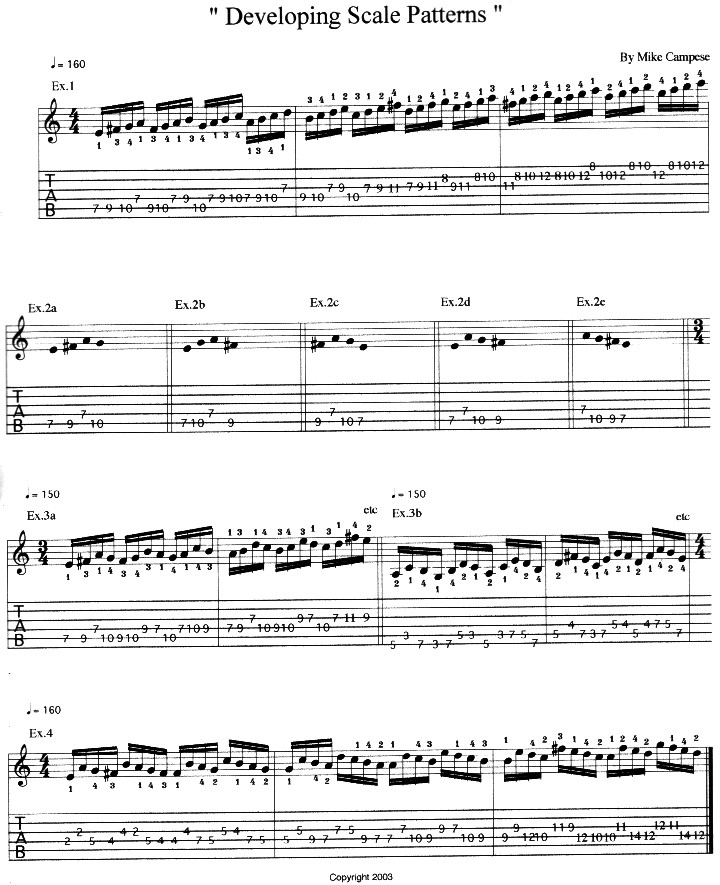Happy New Year everyone! I hope you had a rockin' Christmas and an awesome New Year. So let's start off the new year getting our hands in shape. We are going to talk about developing scale patterns and making up scale sequences. I always love looking for new patterns. A lot of the ones we will use are uncommon. Scales sequences are real important in many ways. They help get your picking and fretting hands in shape; they can also make your solos more exciting. They can also help develop your ear, help you learn the neck, etc. It's the best way to practice scales. We will begin by talking about four note sequences.
Example 1 - Our first pattern is very common - a 4 note sequence in E minor (E, F# ,G ,A ,B ,C ,D).This was one of the first patterns I learned, very cool, but you see it a lot. Make sure you practice this with a metronome; also, pick every note. Don't forget to move this around the neck.
MP3 - Example 1 - Slow
MP3 - Example 1 - Fast
Example 2a-2e - OK, now let's make up some different patterns. We will take the first 4 notes of the E minor scale. You can take these 4 notes and put them in any order you like, then you can march them through the whole scale. There are 24 permutations you can play with those 4 notes. You can number the notes of the scale 1, 2, 3, and 4 and mix them up like 1, 2, 4, 3, or you can do 1, 3, 4, 2, etc. I'm giving you 5 different ones to start you off. Take those combinations and move them in the Em scale. Make sure you experiment with the rest of the permutations. This idea works in any scale.
Example 3a - If you are a little confused about this, example 3a takes the pattern in Example 2a and marches it through the Em scale. I'm only giving you the first 2 bars of it. Try to continue this same pattern all over the neck. Your ear will guide you through it. You will see why this kind of practice will develop your ear.
MP3 - Example 3a - Slow
MP3 - Example 3a - Fast
Example 3b - In this example we'll start with the pattern in Example 2c. We will play this pattern in the 3rd position, still staying in the key of Em. Notice we are doing the same combination through the entire scale.
MP3 - Example 3b - Slow
MP3 - Example 3b - Fast
Example 4 - For our last example we'll mix two combinations together. We are taking examples 2d and 2e and mixing them, but we are moving up the neck on the 4th and 3rd strings. Feel free to move it around on the other strings. Make sure you follow the fingerings on this one. It also helps to palm mute these which makes the notes pop out. Don't forget to accent the downbeats and pick all the notes. Try to work all these examples up to around 150-160 beats per minute. They sound real cool at that tempo.
MP3 - Example 4 - Slow
MP3 - Example 4 - Fast

So you can see that the possibilities are endless. You can make up so many different patterns. You can even try mixing up the rhythms. In our examples, we just used16th notes. OK, I'll leave you with this to mess with. We will talk about modes in our next lesson.
Don't forget, if you have any questions, feel free to email me. Stop by mikecampese.com for upcoming releases, etc. Check out my CDs "Full Circle" and "Total Freedom", and the other CDs on this site, if you have not yet. Look for a new release in early 2003.
Mike Campese is an all-around music performer, session artist and teacher competent in many musical styles, electric and acoustic. He has studied at G.I.T. (Honors Graduate), and with Paul Gilbert, Norman Brown, Stanley Jordan, Scott Henderson and Keith Wyatt.